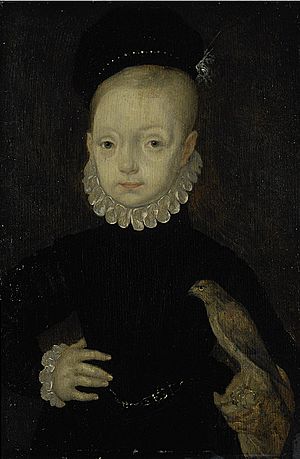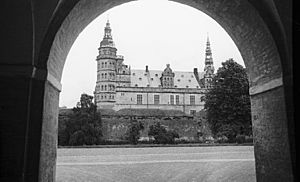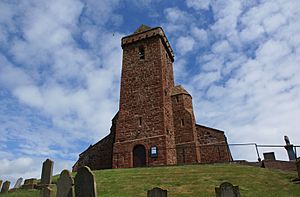Peter Young (tutor) facts for kids
Sir Peter Young (1544–1628) was an important Scottish diplomat and teacher. He was the main tutor to James VI of Scotland when James was a child. Young also held the role of Master Almoner, which meant he was in charge of giving out money to the poor on behalf of the king.
Contents
Early Life and Education
Peter Young was born in Dundee, Scotland, on August 15, 1544. His father, John Young, was a respected citizen of both Edinburgh and Dundee. His mother, Margaret, came from the Scrymgeour family.
Young went to the Dundee Grammar School. He likely studied at St. Andrews University too, as he was called 'Magister' (Master), a title for those with a university degree. In 1562, he traveled to Europe to continue his studies. He lived with his uncle, Henry Scrimgeour, in Geneva, Switzerland, until 1568.
Teaching a King: James VI's Tutor
Peter Young was known for being a great scholar. In 1570, he was chosen to be a joint-teacher for the young King James VI. He worked alongside George Buchanan, another famous scholar. Since Buchanan was older, Young probably did most of the teaching.
Young was very good at his job and became a favorite of the young king. He stayed a trusted advisor to King James throughout his life.
Helping with the King's Library
Young played a big part in building the king's personal library. He kept a list of all the king's books, which even included notes and exercises written by the young king himself.
He often bought books for the king, and also for George Buchanan and the Countess of Mar. He would write to important people like Lewis Bellenden to make sure payments for the books were made quickly. For example, in 1580, he bought books worth £100 from a printer named Thomas Vautrollier. Sadly, in 1582, he lost £70 worth of books to pirates who attacked a ship carrying them from London. Many of the king's books were bound in Edinburgh by John Gibson.
Young also helped the king by decoding secret letters from agents of Mary, Queen of Scots. He even created special code keys for the English ambassador, Henry Killigrew.
In 1577, Young was given the job of Master Almoner in the king's household. This meant he received many gifts and payments over the years. In 1581, the king's favorite, Esmé Stewart, gave him the use of lands near Arbroath.
Diplomatic Missions to Denmark
Finding a Queen: The Royal Marriage
In July 1586, Peter Young went on his first important trip as a diplomat. He traveled to Denmark with Colonel William Stewart to meet Frederick II of Denmark. They were there to talk about the Orkney islands and other secret matters. Some people thought Young wasn't important enough for such a big job, but the English ambassador, Thomas Randolph, described him as "wise, honest, and learned." One of the main topics of discussion was the possibility of King James VI marrying a Danish princess.
Young wrote to King James from Helsingør, Denmark. He explained that King Frederick II was away, so they had to wait in Copenhagen. When he returned to Scotland, Young became a member of the Privy Council of Scotland in November 1586, a group of the king's closest advisors.
In March 1587, King James sent Young and Sir Patrick Vans on another trip to Denmark. This time, the main goal was to arrange a marriage for James VI with one of Frederick II's daughters. Young suggested Elizabeth, the oldest daughter. However, she was already promised to someone else.
Later, it was suggested that King James marry the second daughter, Princess Anne. People said that while Elizabeth was more beautiful, Anne was still very attractive and would grow to be taller. When Frederick II died in 1588, the marriage talks were put on hold.
In early 1589, Young went to Denmark again to finish the marriage plans. After he returned, he joined King James VI on a trip to Oslo, Norway, for the wedding on October 23, 1589.
Managing the Queen's Finances
After the wedding in Oslo, on November 24, 1589, Anne of Denmark received special lands in Scotland as a "morning gift." These included the lordship of Dunfermline and Falkland Palace. This gift was officially confirmed in May 1590.
In July 1593, the Scottish Parliament chose Young to be part of a special group of nine people. Their job was to manage Queen Anne's income from her lands. They advised the queen on her finances, checked her accounts, and helped with new agreements for tenants. This group later became known as the Octavians in 1595, and they briefly managed Scotland's money.
Welcoming Prince Henry
In 1594, Queen Anne gave birth to her first son, Prince Henry. Young was sent to Denmark to share this happy news with Christian IV, Anne's brother. He also invited Danish ambassadors to the prince's baptism celebration. Young also explained that a disagreement over the queen's ownership of lands like Musselburgh had been settled.
King James VI rewarded Young for all his hard work on the marriage and his trips to Denmark. He confirmed Young's rights to lands in Forfarshire, including Easter Seaton.
Attending a Coronation
In May 1596, King James VI was invited to Denmark for the coronation of Christian IV. James sent Lord Ogilvy and Peter Young as his representatives. They offered James's good wishes and apologized for the absence of James and Anne. They also asked for ships and soldiers to help with a planned mission against the Western islanders of Scotland.
Discussing the English Throne
King James VI was very interested in becoming the next ruler of England after Elizabeth I of England. In 1598, he sent David Cunningham and Peter Young on a special trip to Denmark and other German states. James wanted their support, including military help, in case Elizabeth died. He suggested that Elizabeth was old and not well.
Christian IV, the King of Denmark, responded carefully. He said he couldn't promise military help right away. However, he would send friendly letters to other European princes to support James's claim to the English throne.
While in Europe, Young and Cunningham met David Chytræus, a scholar who had written something negative about Mary, Queen of Scots. King James was unhappy about this, so he told Young to talk to Chytræus and get him to take back his statements.
Young and Cunningham visited several other important leaders in Germany. They all gave polite but cautious answers. When Young and Cunningham returned to Denmark, Christian IV offered to send his own ambassador to England.
Young and Cunningham returned to Scotland in November 1598. The English agent, George Nicholson, heard that the Danish and German leaders would not act on James's behalf before Elizabeth's death. Even though they spent a lot of money, the ambassadors received "but this slender answer."
Later Life and Legacy
In 1598, Young was part of a group that looked into the state of Scottish universities. When King James went to London in 1603 to become King of England, Young went with him. James wanted to make Young the Dean of Lichfield, a church position, but found he couldn't.
Young kept his job as chief almoner in the royal household. In November 1604, he became the main tutor and "chief overseer" for Prince Charles, who would later become king. This job came with a pension, which increased when Young was made a knight in 1605.
In 1616, Young was appointed master of the Hospital of St Cross in Winchester, England. He was allowed to hold this job even though he wasn't a priest and didn't live there. Around 1620 or 1623, Young wanted to return to Scotland to live out his final years. The king helped him get paid any money he was owed.
Young had bought the Easter Seaton estate near Arbroath in 1580 and built a house there three years later. Only one stone from that house, with the date and his initials, remains today. He spent his last years there and died on January 7, 1628, at the age of 83.
He was buried in the vault of St Vigeans Church, near Arbroath. A special stone tablet with a Latin message marks his grave.
Family Life
Sir Peter Young was married three times.
Elizabeth Gibb
In 1577, he married Elizabeth Gibb (who died in 1595). She was the sister of John Gibb, a gentleman who worked for the king. Elizabeth also worked for Queen Anne, making head coverings and veils for her.
Peter and Elizabeth had twelve children, including seven sons and three daughters:
- James Young and Henry Young were twins. James became the heir and worked for the king.
- Patrick Young was the king's librarian.
- Peter Young and Robert Young were also twins. Peter junior went on a diplomatic trip in 1628. Robert worked for Prince Henry.
- John (1585–1654) became the Dean of Winchester, an important church leader.
- Marie or Maria Young worked for Queen Anne. She married John Douglas in 1595.
- Margaret Young married David Lindsay.
- Frederick Young and Johanna Young were twins.
- Anna Young was his twelfth child.
Joanna Murray and Marjory Nairne
Peter Young's second wife was Janet Murray. She had been married twice before. They married in early 1596 but she died just six months later in November 1596.
In 1600, Sir Peter married his third wife, Marjory Nairne. They had four daughters, including Nicola Murray, who married David Boswell. Marjory survived him.




